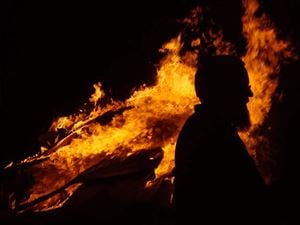
Before the blend of horror, street festival, and commercial enterprise that is our modern-day Halloween, there was the Celtic festival of Samhain. But while this Old World celebration may be the root of the holiday we know today, it’s different than you might expect.
Many hold certain assumptions about Samhain—pronounced sow-in—and a greater number have never heard of it at all. The legends which surround it speak of unnamable horrors, sinister spirits, and human sacrifice. But despite the centrality of fear in our contemporary Halloween celebrations, is that really what Samhain was once about?
Was it truly an event steeped in a spirit of fear, or was the spirit of Samhain something different altogether? Let’s dig into the truth of this ancient holiday and find out exactly what those Celts were up to.
Ancient Origins
Tracing Samhain is a problem. Not only do 2,000 years separate us from those who celebrated it, but there’s also the problem of the Roman Empire.
The ancient Celts had no written language, and their stories, legends, and traditions were passed down orally—through spoken words. And so when they were overtaken by their enemies their legends died along with their language.
The Romans, who conquered the Celts around 43 A.D., were the ones who recorded and presented Celtic traditions to the rest of the world. Because the Romans had a dim view of the Celts, it’s hard to know what Samhain was really about, and so we should take its history with the proverbial grain of salt.
Here’s what historians know about Samhain. The Celts celebrated their new year on November 1st, the day which marked the end of the harvest season, and the beginning of winter’s icy approach.
To commemorate this day, they would build huge bonfires, from which they would later light the smaller fires in their homes in symbolic protection from the coming cold. Some communities would build two bonfires, walking between the two towering stacks of flame with their livestock in a cleansing ritual.
On this day, they also feasted on harvested food, and slaughtered animals for the winter. Some would also wear animal skins and heads as costumes and play pranks.
But this wasn’t a frightening event—it truly was a celebration, one full of joy and merriment. But now that we know the “how” of Samhain, let’s look at its spirit—the “why” behind the holiday.
The Spirit of Samhain
The word “liminal” refers to a transitional phase—to a time between times. And if any word were to be applied to the ancient festival of Samhain, it’s liminal. November 1st was the time when the Celts felt that the veil between the worlds of the living and the dead was thinnest, and when the spirits could most freely intermingle pass over to our world.
And so Samhain was a time representing the tipping point between bounty and scarcity, between rise and decline, and between life and death. But this wasn’t a morbid time—rather, it was a time to honor and respect the dead, and seek protection from winter’s icy fingers.
The bonfires may have been lit in imitation of the sun, invoking its power to encourage growth and hold back the darkness and cold, as well as its power to destroy evil.
This same reasoning lies behind the Samhain practice of carrying flame from the great bonfires to individual homes—this protection was thought to be carried along with it. Families would douse the flame which had been burning in the hearth, replacing it with fire from the Samhain flames, representing renewed power.
Costumes were worn during Samhain to fool malevolent spirits by impersonating them, a practice which was probably the precursor to our modern-day Halloween costumes.
Offerings of food and drink were also left for roving spirits. It was believed that these spirits could either help or harm crops and livestock in the coming months, and so these offerings were meant to bring spiritual help, rather than hindrance.
When the feasts of Samhain were set, places were made for the spirits of deceased loved ones—this was a way to both remember and respect the dead.
Autumn is the ultimate time of transition. The leaves begin to change, and then fall, representing the passing of summer and the coming of winter. We can see that the spirit of Samhain wasn’t one of fright and horror. The spirit of Samhain, rather, was a leaf-strewn thing—one steeped in the autumn in-between, and the hope for an easy winter. It was steeped, also, in respect for the spiritual world, and the fragility of human life.
A Continuing Tradition
Eventually, the Celtic traditions of Samhain were absorbed by the Catholic Church, becoming All Saints’ Day and All Souls’ Day, which fell on November 1st and 2nd. The customs of these holidays included dressing up in costumes and going from door-to-door, begging for special “soul-cakes” in return for prayers.
Sound familiar?
This Autumnal connection between the realms of life and death has survived through the thousands of years since the end of the ancient Celts. Immigrants from Ireland and Scotland brought the traditions of Samhain, All Saints’ Day, and All Souls’ Day to America, and the full commercialization of the holiday began in the early 1900s, when mass-produced decorations began to appear.
By the 1930s, Halloween costumes began to appear, and by 1950, the custom of trick-or-treating was firmly ensconced in American culture.
Today, we tend to focus more on candy and spookiness, but ask anyone, and they’ll still tell you that there’s just something different about Halloween season. There’s a spirit on the air, a liminal feeling that’s in the leaves, wind, and moon.
It’s still a time when the veil is thin, and whether you take that as metaphor or reality, take some time this Halloween to remember the true spirit of Samhain by being thankful for bounty, respectful of the dead, and aware of the possibility that there just might be something out there that lies beyond the physical.

